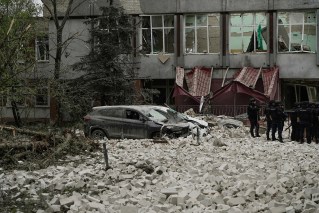Tibetan people funnelled into factory work by China, research shows

Farmers invited to “volunteer” for factory work. A neighbourhood watch system transforming villagers into spies. And educational door-knocks designed to “transform thinking”.
Chinese documents relating to a new mass labour program bear many similarities to Beijing’s descriptions of its handling of its Uyghur population.
A new report released overnight Tuesday suggests that in the first seven months of 2020, Tibetan authorities trained more than half a million so-called “rural surplus labourers” as part of a move to funnel farmers and villagers into factories.
Official documents analysed by researcher Adrian Zenz, and published on the Jamestown Foundation’s website, point to evidence that – like in Xinjiang province – the policies being implemented in Tibet could promote a long-term loss of linguistic, cultural and spiritual heritage.
Dr Zenz is a US-based researcher on Xinjiang and Tibet. Earlier this year, his research unveiled a sharp drop in Xinjiang’s birth rates, which the government later confirmed.
He has also played a leading role in the analysis of leaked Chinese government documents including “China Cables” and the “Karakax List.”

Military-style training of “rural surplus laborers” in the Chamdo region of Tibet, June 2016. Photo: Tibet’s Chamdo/The Jamestown Foundation
Dr Zenz’s latest research has exposed how Tibetan people are being forced to undergo “military-style” vocational training for pre-arranged jobs.
The training aims to reform Tibetans’ “backward thinking” and “dilute the negative influence of religion,” according to government documents cited in the report.
Poverty alleviation reports bluntly say that the state must “stop raising up lazy people”.
Tibetans are to be transformed from “[being] unwilling to move” to becoming willing to participate, a process that requires “diluting the negative influence of religion.”

Examples of “military-style” vocational training for ethnic Tibetans in the Chamdo region. Photos: Chamdo/ Sina / The Jamestown Foundation
Tibetans are also encouraged to hand over their land and herds to the government and become wage workers.
“There are clear elements of coercion during recruitment, training and job matching, as well as a centralised and strongly state-administered and supervised transfer process,” Dr Zenz wrote.
“While some documents assert that the scheme is predicated on voluntary participation, the overall evidence indicates the systemic presence of numerous coercive elements.”
Tibet has a population of about 3.2 million people, strewn across a tightly controlled region the size of South Africa.
The program, which was set up over the past two years, is reminiscent of China’s policies in the western region of Xinjiang, where hundreds of thousands of members of ethnic minorities have been placed in so-called vocational training centres over the past four years and then sent to work in factories across the country.

The “Chamdo Golden Sunshine Vocational Training School” in the Chamdo region of eastern Tibet. Photo: The Jamestown Foundation
“As with the Uyghurs in Xinjiang, overcoming Tibetans’ resistance to labor transfer is an integral part of the entire mechanism,” Dr Zenz wrote.
Chinese documents state that the “strict military-style management” of the vocational training process causes the “masses to comply with discipline” and “continuously strengthens their patriotic awareness”.
The programs’ architect is Chen Quanguo, the Communist Party leader in Xinjiang, who was previously in charge of Tibet.
As in Xinjiang, neighbours are encouraged to spy on each other and dob in fellow villagers who aren’t complying with the rules.
“Coercive elements play an important role during the recruitment process,” Dr Zenz reported.
“Village-based work teams, an intrusive social control mechanism pioneered by Chen Quanguo, go from door to door to ‘help transform the thinking and views of poor households’.”
Chinese documents refer to “grid management”, a highly intrusive social control mechanism, through which communities are subdivided into smaller units of surveillance and control.
“Besides dedicated administrative and security staff, this turns substantial numbers of locals into ‘volunteers’, enhancing the surveillance powers of the state,” Dr Zenz wrote.
Beijing has maintained its Xinjiang policies are needed to curb terrorism and separatism.
There does appear to be one important difference between Beijing’s approaches in Xinjiang and Tibet: there is yet to be any evidence Tibetans are being imprisoned.
“However, in a system where the transition between securitisation and poverty alleviation is seamless, there is no telling where coercion stops and where genuinely voluntary local agency begins,” Dr Zenz concluded.
-with AAP








